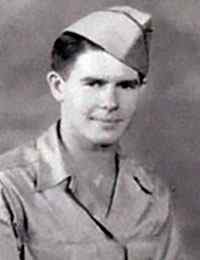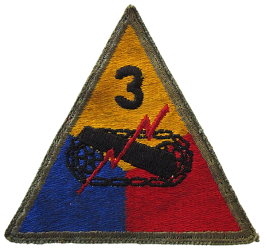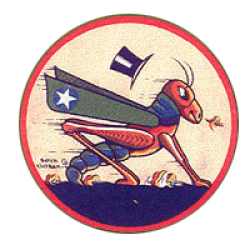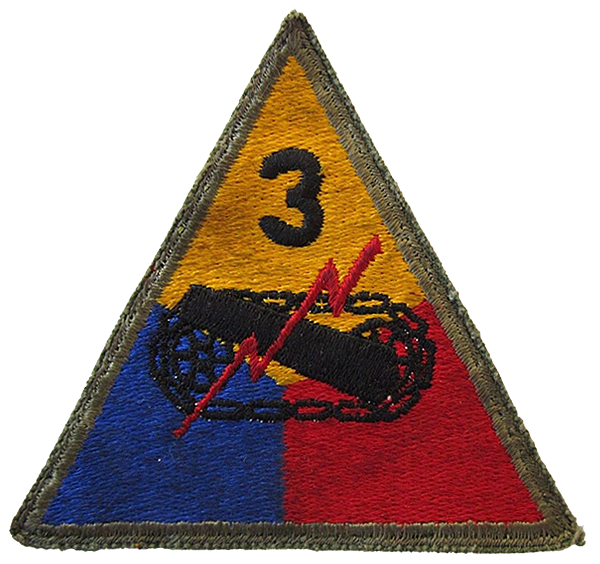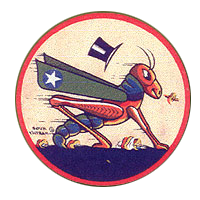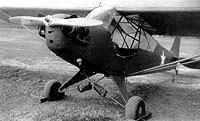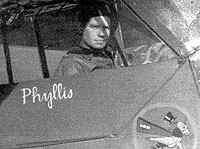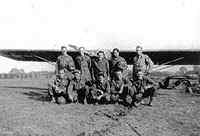After the draft and basic training, I eventually went to OCS, followed by flight training, then was stationed in England for nine months as a liaison pilot with the 3rd Armored Division. We arrived at our port of embarkation, Weymouth, on June 18th 1944 and were issued D and K rations, motion sickness pills and vomit bags. Here we loaded on LST's (Landing Ship Tanks). As we started out of the harbor, there was a collision between two ships that blocked the passage, so we returned to dock. The next day we sailed again but were turned back by high seas and stormy weather, which made landing on the beach impossible. Most of the guys on the ship got really sick. In fact, one of the lieutenants in our battery thought he was going to die. As long as he was lying down, he was OK, but as soon as he sat up in his hammock, he turned green and heaved.
The LST's, being relatively small, were really buffeted by the rough sea. Although the officers had a dining room, it was impossible to sit at the table and eat because the tin plates would slide from one end of the table to the other. I was not too affected with nausea, probably because of all the flying I had done. I'm sure there is a relationship between airsickness and seasickness. Much of the sickness was probably intensified by fear and apprehension. Although beachhead had already been established, it was rumored that the Germans were ready to launch a counteroffensive and drive the allied troops back into the sea. It was possible that we would get there just at that time.
When we arrived at Omaha Beach just below the village of Isigny, the scene was mass confusion, a lot of broken equipment, smashed tanks, twisted landing craft, and much half-submerged wreckage. Corpses floated by, one of which became entangled in the propeller of the LST I was on. Strips of barbed wire lay helter-skelter on the sandy beach. Many large ships, part of the invasion armada, sat offshore, still firing big guns over our heads and inland. The first day we spent de-waterproofing our vehicles, but we didn't take our planes off the 6x6 trucks until later, when we were inland and could find a pasture big enough from which to take off. There had been some debate prior to the crossing as to why we couldn't just fly the planes across the channel. The division artillery commander thought that there would be so much air activity and so many barrage balloons around the beach that it wouldn't be practical, and, of course, he was right. Thus we removed the wings and placed our Cubs on 6x6 trucks and loaded them aboard the LST.
The first days, everyone was a little scared because of the occasional sniper firings on our positions. I recall vividly a frightening moment for me. I started out in my jeep to locate battalion headquarters, and as I drove down a narrow road between hedgerows, around a curve some 20 yards ahead there suddenly appeared a German Tiger tank. My jeep driver and I both hit the ditch, but as it turned out, the tank was a captured one, which was being driven by one of the guys in our outfit. I was probably never more scared than at that moment.
Fighting in Normandy was not suitable to an armored division. The terrain was flat, with lots of poplar trees and high, earthbound hedgerows around the small fields. It was almost impossible for our tanks to break through the hedgerows, and if they did, they'd be hit immediately by a bazooka or by an anti-tank gun. The tanks would burst into flame and black smoke, giving the crews inside no chance for escape. Burned bodies are neither pretty nor easy on the sense of smell. When pulled out of a cooled tank, the bodies of six-foot-tall men would be half that size. We left a lot of tanks and crews in Normandy.
Because of the terrain, it was difficult for our ground forward observers to see targets, so our Cub planes directed most of the firing. The success of the fire direction from the planes quickly made believers of Colonel Berry and other battalion commanders who might have had misgivings about the use of liaison planes in directing artillery fire. They began to depend on the Piper Cub, not only to spot targets and direct artillery fire, but also for reconnaissance in locating new gun positions and battalion routes of advancement.
We didn't see much of the Luftwaffe during the daytime in Normandy, but at night we could expect a rather steady bunch of antipersonnel bombs. Since we were not moving our landing strip every day, we had time to dig slit trenches, where we slept, always with our steel helmets on. Later, after the breakthrough at St. Lo, we were moving every day, often sleeping under the half-track, in a natural ditch, or in the cellar of a vacated house. The breakthrough at St. Lo was touted as the greatest combined air-ground operation in history.On the morning of July 26, wave after wave of Fortress and Liberator bombers roared over us. According to the records, there were 1800 heavy bombers, 1400 medium bombers, and 700 fighter-bombers, all operating in a small area. It was total saturation bombing.
Col. Berry, who arrived at our landing strip almost as soon as the first wave came over, joined me as we cruised along at about 500 feet, watching the bombing. It was really awesome! The first wave of bombers dropped smoke bombs to mark the front lines so that the succeeding bombers would have a target. Unfortunately, there was a disastrous miscalculation in wind direction, and the smoke immediately started to drift back over our own front lines. As a result, many, many bombs were unloaded onto our own troops. Col. Berry and I could see exactly what was happening and radioed down to our headquarters. This uncovered the second big goof in planning. There was no direct radio contact between the forces on the ground and the air forces. Thus there was no way to stop the carnage. It was a truly helpless feeling. There were bodies lying everywhere, crews loading those bodies onto 6x6 trucks. stacking them like cordwood, and a sickening stench from the human bodies and from the bloated carcasses of cattle and horses as well, also innocent victims of the bombing.
Throughout the war it was a common sight to see French and Belgian peasants carving up the cows and horses that had been killed a day or so before by bombs or ground fire. Food was scarce in the areas where fighting had occurred. Shortly after we crossed into Belgium, I was flying alone, looking for a field where I could move my section. I landed in a pasture and taxied up to a line of trees. I got out of the airplane and lit a cigarette. I wasn't wearing my pistol and doubt if I even had it in the plane. A German soldier, a member of the Wehrmacht, came from behind the trees and handed me his rifle. He could so easily have shot me, but evidently he was not a "good soldier," just a human being. I took his gun, shook his hand and pointed toward the highway below where some of our columns were moving. I never saw him again, but I hope he found someone to whom he could surrender peacefully.
Usually, if we "grasshopper" pilots saw enemy fighters in time, we could elude them by diving and flying close to the ground, following the contour of the terrain. At the speed the fighters flew, they could not turn as quickly as our Cubs could, so that if they missed us with their initial shots, we could usually outmaneuver them. One liaison pilot I knew actually caused a Messerschmitt to fly into a hillside during the chase. He proudly painted a Messerschmitt kill on the nose of his Cub. During the period between the second week of November and the middle of December, my crew and I settled down for a period of recovery and maintenance. I moved my section to a pasture field beside a large dairy farm near the village of Walhorn. It was known as the Belven farm and was owned by a family of Germans named Egyptien. The family, father, mother and four daughters, invited us to stay in their house with them, and they did everything possible to make us feel welcome. Their hospitality was unreal.
After all, we were the "enemy." When I finally moved my section closer to the battalion headquarters at Stolberg in mid-December, three of us left our dress uniforms at the Egyptiens and said that we'd be back for them when we needed them. In early March, after the Battle of the Bulge, I went on a three-day pass to Liege and on the way stopped at the farm to pick up my uniform. I learned then that the Egyptiens feared that they would be in the path of Rommel's advance through the Ardennes, and that the uniforms might be discovered in their house. They had carefully wrapped the uniforms and buried them in the courtyard, then moved a large pile of manure over the spot! After the Battle of the Bulge was over, they dug up the uniforms, carefully cleaned and pressed them and put them back on hangers in the bedroom. They told us that they, as well as we, were victims of a war that shouldn't be. They were Germans, but not Nazis.
The Battle of the Bulge was a time of confusion for all of us. The ground was snow covered, the air was thick with fog, and it was very difficult for my section to keep up with the ground troops. No one knew where the front really was. Because the Germans were dressing some of their troops in American uniforms, no one trusted anyone.I managed to get our air section moved to the little village of Morrville on Christmas Day. It was too cold and the ground too frozen to dig slit trenches, so we slept in an old hay barn on Christmas night and for the next couple of days. We must have been located right on the path of buzz bombs. I have a vivid recollection of listening to them fly over all night long wondering when one of them might dysfunction and come down on us. They always sounded as though their engines were ready to quit. A day or two after Christmas, I was riding in our half-track vehicle on the way to battalion headquarters, when the front wheel ran over the feet of a frozen dead soldier covered with snow. It caused the corpse to flip up out of the snow right by the side of the half-track. That was a genuine Halloween experience.
Nordhausen, which we reached on the eleventh of April, was a place of horror. Camp Nordhausen was a Nazi slave extermination campground. Decomposing bodies were everywhere, and the stench was unbearable. Wandering among the dead were emaciated, ragged and starving prisoners, who were so far gone that few had any chance of surviving. Most were, I understand, labeled as political enemies of the Third Reich, German, as well as other European nationals. After being liberated, those who were able to walk just staggered about aimlessly, staring straight ahead. We learned that the procedure in the camp was to hang thirty-two men each day, while the entire garrison watched. Then the prisoners who were able hauled the bodies to the ovens. History relates about the Jewish holocaust, but I have read very little about Nordhausen and the neighboring Camp Dora, where the prisoners worked to build Vl and V2 weapons, the robot or buzz bombs. It was an ugly scene. It has been well over 50 years since I saw Nordhausen, but even now, when I see someone walking along the highway, I am reminded of the liberated prisoners in their striped uniforms aimlessly shuffling along the roads leading out of Nordhausen.
After Nordhausen, we were bivouacked on Friday the 13th of April at the little village of Gerbstedt. The next day, while flying over our column of tanks, we were attacked by eight Messerschmitts strafing the column, two of which came after me. With tracer bullets all around the airplane, I panicked and "hit the deck," crash-landing in a plowed field, where the Cub nosed over on its back. I was strapped upside down and remember having a frantic time trying to get the seat belt loosened so that I could get out. The Messerschmitts made a couple of strafing passes at my plane, and at me, as I ran across the field to the column of tanks, the bullets kicking up the dirt around me as I ran. At the same time, I was trying to shed the cumbersome parachute I was wearing. It would be a gross understatement to say simply that I was scared. At any rate, I survived both Friday the 13th and the day after. We were able to salvage the plane, but the landing gear, the propeller, and the rudder had to be replaced.
Like most soldiers in combat, I lost several good friends. Of the four officer-pilots and the three noncommissioned pilots with the 3rd Armored Division on D-day, only two of us lived to return to the States. Of those killed, two crashed into the ground, two flew into the trajectory of one of our own shells, and one was shot down by enemy aircraft. The record shows that the 3rd Armored Division had 10,371 total casualties: 2214 KIA, 706 MIA, and 7451 wounded. Such is the glamour of the "good" war.
